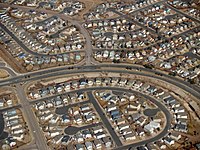
Photo from wikipedia
Background As many children do not meet the recommended daily physical activity (PA) levels, more research is needed towards environmental determinants of children’s PA levels. The aims of this longitudinal… Click to show full abstract
Background As many children do not meet the recommended daily physical activity (PA) levels, more research is needed towards environmental determinants of children’s PA levels. The aims of this longitudinal study were to investigate whether the physical environment and parenting practices have an impact on changes in children’s weekday time spent at various PA levels and whether associations between physical neighbourhood environment and changes in children’s PA are moderated by parenting practices. Methods We performed a secondary data analysis of longitudinal data collected at three timepoints (baseline, 6, and 18 months) from 10 control schools of the Active Living study, a quasi-experimental study, which took place in South Limburg, the Netherlands. In total, 240 children aged 8–12 years were included in the analyses. PA levels were measured using accelerometry (ActiGraph GT3X+). The physical environment was assessed at baseline through neighbourhood audits of the school environment, and PA parenting practices were measured at baseline via validated parental questionnaires. Multivariate multilevel regression analyses were conducted to determine the main effects of the physical environment and parenting practices on changes in children’s time spent in sedentary behaviour (SB), light PA and moderate-to-vigorous PA (MVPA) over 18 months. Additionally, moderation of the association between the physical environment and children’s PA levels by parenting practices was examined by adding interacting terms to the regression equations. Results Walkability of the physical environmental was associated with a decrease in SB at 18 months (B = -5.45, p < .05). In addition, the parenting practice logistic support was associated with an increase in MVPA (at all time points, B = .68, B = .73 and B = 1.02, respectively, all p < .05) and a decrease in SB (at 18 months, B = -1.71, p < .05). Stratified analyses (based on significant interaction terms) showed that the effect of specific physical environmental features (e.g., sports facilities) on children’s improvements in PA levels were strengthened by favourable parenting practices. Discussion Besides the main effects of walkability and logistic support, there were indications that several parenting practices moderate the association between the physical environment and changes in children’s time in various PA levels. The current findings are exploratory, and need to be confirmed in further research.
Journal Title: BMC Public Health
Year Published: 2021
Link to full text (if available)
Share on Social Media: Sign Up to like & get
recommendations!